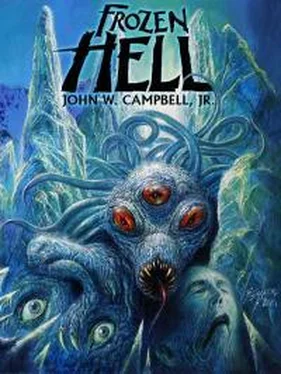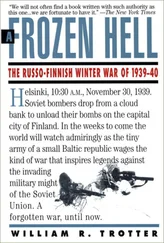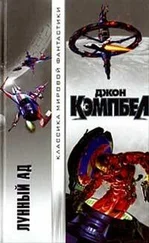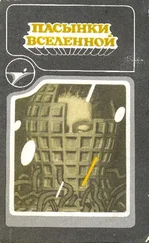Джон Кэмпбелл - Frozen Hell
Здесь есть возможность читать онлайн «Джон Кэмпбелл - Frozen Hell» весь текст электронной книги совершенно бесплатно (целиком полную версию без сокращений). В некоторых случаях можно слушать аудио, скачать через торрент в формате fb2 и присутствует краткое содержание. Год выпуска: 2019, Издательство: Wildside Press, Жанр: Фантастика и фэнтези, на английском языке. Описание произведения, (предисловие) а так же отзывы посетителей доступны на портале библиотеки ЛибКат.
- Название:Frozen Hell
- Автор:
- Издательство:Wildside Press
- Жанр:
- Год:2019
- ISBN:нет данных
- Рейтинг книги:3 / 5. Голосов: 1
-
Избранное:Добавить в избранное
- Отзывы:
-
Ваша оценка:
- 60
- 1
- 2
- 3
- 4
- 5
Frozen Hell: краткое содержание, описание и аннотация
Предлагаем к чтению аннотацию, описание, краткое содержание или предисловие (зависит от того, что написал сам автор книги «Frozen Hell»). Если вы не нашли необходимую информацию о книге — напишите в комментариях, мы постараемся отыскать её.
Frozen Hell — читать онлайн бесплатно полную книгу (весь текст) целиком
Ниже представлен текст книги, разбитый по страницам. Система сохранения места последней прочитанной страницы, позволяет с удобством читать онлайн бесплатно книгу «Frozen Hell», без необходимости каждый раз заново искать на чём Вы остановились. Поставьте закладку, и сможете в любой момент перейти на страницу, на которой закончили чтение.
Интервал:
Закладка:
“Brain-Stealers of Mars” was no more than a clever piece of hackwork nicely suited for the undemanding requirements of \ Thrilling Wonder Stories . Campbell quickly followed it with further Penton and Blake adventures for Weisinger. But he still yearned to break away from the low-paying science-fiction magazines, and in the spring of 1937, he paid a call on Jack Byrne, the editor of Argosy , who had let it be known that he wanted to publish more science fiction but had no idea where to find it.
Campbell told of his meeting with Byrne in a letter to his best friend, Robert Swisher, a pharmaceutical chemist and avid science-fiction reader who lived in a suburb of Boston: “Byrne was offered a collection of story ideas, including the human mutant one, but he liked best the idea of the Thusol [sic] from ‘Brain-Stealers of Mars’. I told him I’d done it in a humorous vein—comic opera possibilities of course obvious—for Wonder . Would he like it done in a horror vein, with the setting Earth instead of Mars.… He would. Wants 24,000, 35,000, or 44,000 words of it. They pay 1-1/4 to 1-1/2 cents a word for their stuff—34,000 of them sound interesting.… Byrne said he didn’t think the Thusol should be let loose on Earth—inject ’em into a movie colony on location—or on a desert island or something—in a city would be too darned much, and too impersonal. (Think he’s right myself.) The horror angle there is—they might get loose.… I finally decided they get loose in an Antarctic expedition, when one was thawed out of the Antarctic ice.…Starts with the finding of things. Biologist puts frozen beast in the one cabin that’s kept warm all night, so that it can thaw out for dissection; the hut where the meteor observer sits alone all night. Something stirs behind him—he turns.
“The next morning—he finds animal gone. Great curiosity. Meteor man says he didn’t hear a sound all night—wanders off— He’s missing later, but they find a cow in the passage, half molten, and a three-foot image of meteor man growing from it—it runs—they learn the horrible truth.”
Thus was the future classic “Who Goes There?” born. But there was many a step, and a misstep or two, between the initiation of the idea and the final great story.
Campbell set out immediately to write it, working at his usual high speed, and by June, 1937 had done his new story employing the shapeshifting monster theme, setting it on an Antarctic base that he envisioned after reading the account of Admiral Richard E. Byrd’s recent expedition to the south polar regions. He may also have been influenced to some degree by H.P. Lovecraft’s novella “At the Mountains of Madness,” which had been serialized in Astounding in 1936—a powerful tale with an Antarctic setting, although Lovecraft’s style and narrative approach had very little in common with Campbell’s. A third factor that may have enabled Campbell to intensify the impact of his shapeshifter plot was a strange autobiographical one that Campbell revealed many years later: his mother had been one of a pair of identical twins, so much like each other that as a small boy he was unable to tell them apart. The sisters disliked each other and the aunt disliked her nephew, and on occasion he would come home from school to seek comfort from his mother for some mishap that day, only to be coldly rebuffed by a woman who was actually his aunt.
He called the new story Frozen Hell , thus recycling the title of his unsold and apparently unsalable novel of lunar exploration of the year before. His intended market was Argosy , but when Jack Byrne of Argosy called him into the office to discuss the story, it was to tell him of its rejection. As Campbell wrote to his friend Swisher, Byrne had said “‘it’s a good yarn, good idea, good writing. But there aren’t any characters in it. It’s got a bunch of minor characters, but no major characters.’ Quite true—I can see that. Hence, most of the conference revolved about how to bring out characters.” In the 15-minute discussion that followed, Byrne’s associate editor, George Post, suggested that what the story needed was a female character. Campbell was willing to give that a try, but saw no way to make a woman part of a 1930s Antarctic expedition. He went home promising to study the story and find some way to make it acceptable.
Campbell was destined to become one of the most capable editors in the history of science fiction, and I can testify from my own experience of his editorial skills, eighteen years after the time he was working on his Antarctic horror tale, that he had a superb sense of story construction and knew how to guide the author of a not-quite-right work toward a satisfying revision. Those skills must already have been well developed even in 1937, when, after all, he had been writing for the science-fiction magazines for eight years and had published a great many widely admired stories.
We know how he went about shaping the Antarctic novel he called Frozen Hell into the masterly novella “Who Goes There?,” because we have the text of Frozen Hell available for comparison today. No one had given much thought to that original version for many years, though when the Swisher-Campbell letters were published in a limited edition in 2011 it was mentioned; but even then the manuscript was believed to be lost. A few years later, though, Alec Nevala-Lee, while doing research for his book Astounding (an account of Campbell’s influence on science fiction, and in particular of his editorial relationships with Isaac Asimov, Robert A. Heinlein, and L. Ron Hubbard), came upon a reference in Campbell’s correspondence file to a box of manuscripts that Campbell had deposited in the Harvard University library. Nevala-Lee eventually discovered the forgotten box in Harvard’s Houghton Library, and there within it was the Antarctic version of Frozen Hell , now brought forth at last for 21st-century readers.
Comparing the rediscovered manuscript with the published novella is an instructive lesson in Campbell’s growing mastery of his craft. What is immediately apparent when putting one against the other is that Campbell the future editor must have realized at once that he had opened the story in the wrong place. Frozen Hell starts with the discovery of an alien spaceship buried in the Antarctic ice cap, but, though Campbell tells of it in the crisp, efficient prose that had become his professional hallmark, and describes the south polar setting with a vividness worthy of Admiral Byrd himself (“The northern horizon was barely washed with rose and crimson and green, the southern horizon black mystery sweeping off to the pole.…”), nothing that he tells us in the first three chapters of the original version drives the reader toward the terrifying situation that is the mainspring of the novella’s plot. That situation is foreshadowed, in a heavy-handed way, toward the end of Chapter Three, when McReady, who is as close to a protagonist as the story will have, tells of a nightmare he has had (which recapitulates the story line that Campbell had used in “Brain-Stealers of Mars”). In his dream the Antarctic explorers have brought forth a strange frozen creature from the ice that manifests shapechanging powers. “It could turn into anything, or anybody.… It had a secret, unholy knowledge of life and life-stuff, protoplasm, gained through ages of experiment and thought. That is, it wasn’t bound to any form or size or shape, but could mold its very blood and flesh and smallest cell to not merely imitate but duplicate the blood and flesh and cells of any other thing it chose. And read the thoughts, the habits, the mind of anyone.”
This is, of course, the nightmarish central situation we will ultimately encounter in “Who Goes There?” But laying it out in this blunt way, in flat exposition and in the arm’s-length reality of a retold dream, must have struck Campbell, upon re-reading, as a woefully ineffective way of setting up his plot. There were other flaws in the longer version, too. On page 12 we find a scientist named Norris explaining something to McReady, in two paragraphs of leaden dialogue, that McReady surely already knows. (“To a compass the magnetic South Pole is what the true south pole 1,200 miles away is to the geographer; any direction is due north. There is no horizontal pull, the shortest way north is straight down.…”) And on page 35 the Antarctic explorers accidentally destroy the buried alien spaceship in a clumsy attempt to excavate it, though it would have been much more plausible to leave it in the ice to be recovered by some later, and better-equipped, expedition.
Читать дальшеИнтервал:
Закладка:
Похожие книги на «Frozen Hell»
Представляем Вашему вниманию похожие книги на «Frozen Hell» списком для выбора. Мы отобрали схожую по названию и смыслу литературу в надежде предоставить читателям больше вариантов отыскать новые, интересные, ещё непрочитанные произведения.
Обсуждение, отзывы о книге «Frozen Hell» и просто собственные мнения читателей. Оставьте ваши комментарии, напишите, что Вы думаете о произведении, его смысле или главных героях. Укажите что конкретно понравилось, а что нет, и почему Вы так считаете.


![Джон Кэмпбелл - Из мрака ночи [Сборник]](/books/28063/dzhon-kempbell-iz-mraka-nochi-sbornik-thumb.webp)







![Джон Кэмпбелл - Острова в космосе [litres с оптимизированной обложкой]](/books/433450/dzhon-kempbell-ostrova-v-kosmose-litres-s-optimizi-thumb.webp)